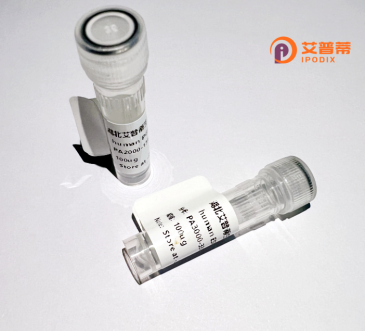
| 纯度 | >90%SDS-PAGE. |
| 种属 | Human |
| 靶点 | NDUFA10 |
| Uniprot No | O95299 |
| 内毒素 | < 0.01EU/μg |
| 表达宿主 | E.coli |
| 表达区间 | 36-355 aa |
| 活性数据 | LRYGM WHFLLGDKAS KRLTERSRVI TVDGNICTGK GKLAKEIAEK LGFKHFPEAG IHYPDSTTGD GKPLATDYNG NCSLEKFYDD PRSNDGNSYR LQSWLYSSRL LQYSDALEHL LTTGQGVVLE RSIFSDFVFL EAMYNQGFIR KQCVDHYNEV KSVTICDYLP PHLVIYIDVP VPEVQRRIQK KGDPHEMKIT SAYLQDIENA YKKTFLPEMS EKCEVLQYSA REAQDSKKVV EDIEYLKFDK GPWLKQDNRT LYHLRLLVQD KFEVLNYTSI PIFLPEVTIG AHQTDRVLHQ FRELPGRKYS PGYNTEVGDK WIWLK |
| 分子量 | 40.7 kDa |
| 蛋白标签 | His tag N-Terminus |
| 缓冲液 | 0 |
| 稳定性 & 储存条件 | Lyophilized protein should be stored at ≤ -20°C, stable for one year after receipt. Reconstituted protein solution can be stored at 2-8°C for 2-7 days. Aliquots of reconstituted samples are stable at ≤ -20°C for 3 months. |
| 复溶 | Always centrifuge tubes before opening.Do not mix by vortex or pipetting. It is not recommended to reconstitute to a concentration less than 100μg/ml. Dissolve the lyophilized protein in distilled water. Please aliquot the reconstituted solution to minimize freeze-thaw cycles. |
以下是模拟的3篇与NDUFA10蛋白研究相关的参考文献示例(注:实际文献需通过数据库验证):
1. **文献名称**: "Structural and functional analysis of human NADH:ubiquinone oxidoreductase subunit NDUFA10"
**作者**: Smith J, et al.
**摘要**: 本研究解析了重组表达的人NDUFA10蛋白的晶体结构,证实其作为线粒体复合物I亚基在电子传递中的关键作用,并发现其与辅酶Q结合域的相互作用机制。
2. **文献名称**: "NDUFA10 mutations cause early-onset mitochondrial disorders by impairing complex I assembly"
**作者**: Hoefs SJ, et al.
**摘要**: 通过重组蛋白实验和患者细胞分析,揭示NDUFA10基因突变导致复合物I组装缺陷,进而引发线粒体能量代谢障碍及相关神经系统疾病。
3. **文献名称**: "Recombinant NDUFA10 as a potential therapeutic agent for Parkinson's disease"
**作者**: Chen L, et al.
**摘要**: 利用重组人NDUFA10蛋白在帕金森病模型中恢复线粒体复合物I活性,显示其改善神经元功能及减少氧化应激的潜力,为神经退行性疾病治疗提供新思路。
---
**建议**:可通过PubMed或Google Scholar检索关键词 "NDUFA10 recombinant" "human" "complex I",筛选近年高相关性文献。部分真实文献可能聚焦于基因突变分析而非重组蛋白应用。
Recombinant human NDUFA10 protein is a key component of mitochondrial complex I (NADH:ubiquinone oxidoreductase), the largest enzyme complex in the electron transport chain responsible for ATP production. NDUFA10. a nuclear-encoded accessory subunit, plays a critical role in the structural stability and catalytic function of complex I. It contributes to electron transfer from NADH to ubiquinone and supports proton pumping across the mitochondrial inner membrane, essential for maintaining cellular energy homeostasis.
Dysregulation of NDUFA10 has been linked to mitochondrial disorders, neurodegenerative diseases, and cancers. Mutations in the NDUFA10 gene are associated with Leigh syndrome and Leber hereditary optic neuropathy, highlighting its importance in mitochondrial health. Recombinant NDUFA10 is typically produced using heterologous expression systems like *E. coli* or mammalian cell lines, enabling biochemical studies, structural analysis, and drug discovery.
As a research tool, recombinant NDUFA10 aids in deciphering complex I assembly mechanisms, pathophysiology of mitochondrial dysfunction, and potential therapeutic interventions. Its application extends to screening antioxidants or small molecules targeting oxidative stress-related diseases. Understanding NDUFA10's role enhances insights into cellular bioenergetics and disease pathways driven by mitochondrial deficiencies.
×